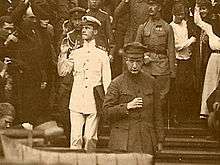French (tunic)
- This article incorporates information from the equivalent article on the Russian Wikipedia.
_01_by_shakko.jpg)

French — (Russian: френч) was the designation of a particular type of military jacket or tunic in the Russian Empire and later in the Soviet Socialist Republics (USSR). Alternative names were kurtka, (ru: куртка), kitel (ru: китель; derived from German: Kittel) or pidzhak (ru: pitzhak; derived from English: pea-jacket).
In the period of World War I 1914—1918 a decisive number of uniform jackets were created, in most cases related to the latest creations in modern armed forces, e.g. France and United Kingdom. These kinds of uniform jackets received the collective designation french in relation to the supreme commander of the British Expeditionary Force to France, John French and field marshal.
Main features of french were as follows:
- soft collar – turndown version or standing version with button fastening,
- variable half-belt and changeable sleeves
- four big pockets (appliquéd, with buttons) with flaps (two upper chest, two below).
In the Workers' and Peasants' Red Army (WPRA) of the USSR it was usually worn by commanding officers, chiefs and political officers and from 1924 to 1943.
In the air force there was a limited number of frenches regularly worn by British officers. It was characterised by an open collar, to be worn with tie or scarf.
Other users
The french was also adopted by several political leaders, such as Vladimir Lenin, Mao Zedong (Mao suit) and Chiang Kai-shek.
References
- Френч. // Крысин Л.П. Толковый словарь иноязычных слов. — Эксмо, 2008. — 944 с.



